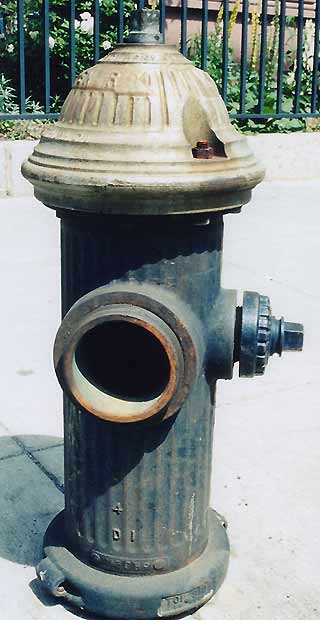LizzieMaine
Bartender
- Messages
- 34,183
- Location
- Where The Tourists Meet The Sea
A few more observations from the 1929 clip...
Directly to the left of the Embassy Newsreel Theatre you'll see the marquee of Keith's Palace, the ultima thule of big time vaudeville, in its waning days as the goal of every hustling hoofer, sister act, and talking comic. At the time this footage was shot, the Palace had just gone from two shows a day to three -- which in the world of vaudeville was a tremendous come-down in prestige. Just three years later, the theatre converted to a movie policy, and vaudeville for all intents and purposes was dead. Perhaps you could sense it was dying when you saw a grimy old milk truck parked in front of the theatre.
Between the theatres showing "Disraeli" and "The Vagabond Lover" you'll catch a glimpse of the stained-glass facade of a Horn & Hardart Automat.
Peek into the windows of the first Nedick's stand that goes by and you'll see a white-garbed counterman leaning against the back wall, with his arms insolently folded. What is it with these shiftless slacker kids today that they don't want to work? If you got time to lean, you got time to clean.
Under the marquee of the Strand, where "Gold Diggers of Broadway" is showing, you'll see a cascade of balloons tied to the framework. The idea was that the color of the balloons would call attention to the brilliant Technicolor hues of the film, but all I can think of is the poor soul who had to get up on a ladder and tie them all in place.
Chin's Restaurant, a couple of doors down from the Criterion Theatre, was part of a small local chain of Chinese eateries. Working there was the fourteen-year-old daughter of the restaurant's founder, a young woman named Grace Lee, who, as Grace Lee Boggs, grew up to become a radical labor/civil rights activist in the 1950s, 60s, and beyond. She died in 2015 at the age of 100, and there's a good chance that of the people in the neighborhood that day that she was the last living soul.
You just can't get away from Nedick's. The service might have been lousy, but the hot dogs must've been really good.
The woman in the light-colored coat rushing into the Metrotone News office at 4:29 will take no crap from anybody.
The guy who jumps up on the running board of the car at 5:26 really wants you to notice him, with his hat at a cocky angle, but he could not have possibly imagined people would be pointing him out of the crowd eighty-nine years later.
Directly to the left of the Embassy Newsreel Theatre you'll see the marquee of Keith's Palace, the ultima thule of big time vaudeville, in its waning days as the goal of every hustling hoofer, sister act, and talking comic. At the time this footage was shot, the Palace had just gone from two shows a day to three -- which in the world of vaudeville was a tremendous come-down in prestige. Just three years later, the theatre converted to a movie policy, and vaudeville for all intents and purposes was dead. Perhaps you could sense it was dying when you saw a grimy old milk truck parked in front of the theatre.
Between the theatres showing "Disraeli" and "The Vagabond Lover" you'll catch a glimpse of the stained-glass facade of a Horn & Hardart Automat.
Peek into the windows of the first Nedick's stand that goes by and you'll see a white-garbed counterman leaning against the back wall, with his arms insolently folded. What is it with these shiftless slacker kids today that they don't want to work? If you got time to lean, you got time to clean.
Under the marquee of the Strand, where "Gold Diggers of Broadway" is showing, you'll see a cascade of balloons tied to the framework. The idea was that the color of the balloons would call attention to the brilliant Technicolor hues of the film, but all I can think of is the poor soul who had to get up on a ladder and tie them all in place.
Chin's Restaurant, a couple of doors down from the Criterion Theatre, was part of a small local chain of Chinese eateries. Working there was the fourteen-year-old daughter of the restaurant's founder, a young woman named Grace Lee, who, as Grace Lee Boggs, grew up to become a radical labor/civil rights activist in the 1950s, 60s, and beyond. She died in 2015 at the age of 100, and there's a good chance that of the people in the neighborhood that day that she was the last living soul.
You just can't get away from Nedick's. The service might have been lousy, but the hot dogs must've been really good.
The woman in the light-colored coat rushing into the Metrotone News office at 4:29 will take no crap from anybody.
The guy who jumps up on the running board of the car at 5:26 really wants you to notice him, with his hat at a cocky angle, but he could not have possibly imagined people would be pointing him out of the crowd eighty-nine years later.



